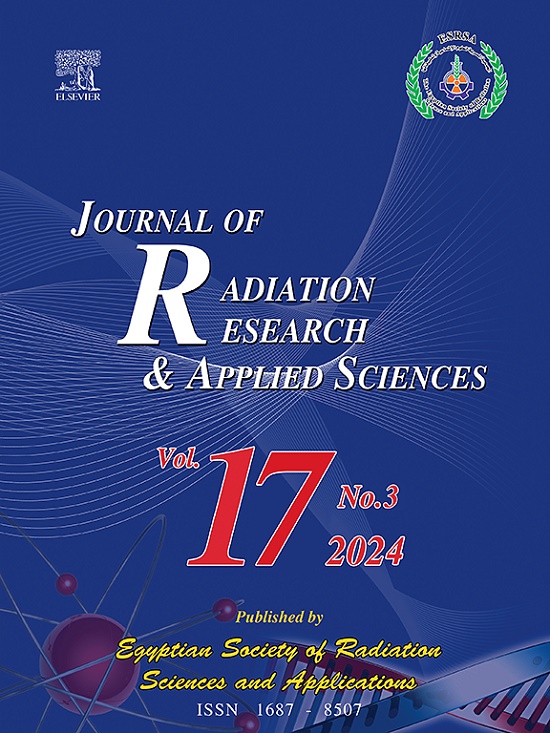Analysis of heat transfer and flow properties of penta hybrid nanofluid in magnetized squeezing flow of Boger-micropolar
IF 1.7
4区 综合性期刊
Q2 MULTIDISCIPLINARY SCIENCES
Journal of Radiation Research and Applied Sciences
Pub Date : 2025-05-21
DOI:10.1016/j.jrras.2025.101633
引用次数: 0
Abstract
This study investigates the unsteady flow and heat characteristics of penta hybrid Boger-micropolar magnetohydrodynamic (MHD) nanofluid between parallel disks, its heat performance, which has drawn significant interest because of its promising application in heat exchangers. The penta hybrid nanofluid consists of blood as the base fluid and five different nanoparticles of Al2O3, ZrO2, Fe3O4, Ag and MoS2. The main goal of this study is to examine the laminar, time-dependent, and incompressible flow of a penta-hybrid nanofluid under the influence of a magnetic field, focusing on the squeezing flow of a Boger micropolar nanofluid between both porous and non-porous disks, while also analyzing its thermal properties. The fluid is subjected to squeezing at the top disk, which is in motion in the axial direction, and a uniform suction/injection at the bottom disk. Energy and velocity slip effects are also considered at the fixed bottom disk. For the analysis of the flow, appropriate similarity transformations are utilized to reduce the governing partial differential equations (PDEs) to nonlinear ordinary differential equations (ODEs), which are then solved numerically using Python. The analysis demonstrates that an increase in the solvent fraction factor (β1) improves the heat transfer and flow velocity, and higher values of the relaxation time ratio (β2) decrease the thermal conductivity. Also, an increase in the magnetic parameter (M) and microrotation (K) increases the resistance to flow and decreases the heat transfer efficiency. The results are presented graphically, illustrating the impact of microrotation, velocity, and temperature profiles, and providing useful information on the thermal performance of the fluid. The results have potential applications in advanced cooling systems, environmental purification, biomedical devices, and energy-efficient heat exchangers, where high heat transfer and control of the fluid are required.
博格-微极磁化挤压流中五杂化纳米流体的传热与流动特性分析
本文研究了五杂化博格微极磁流体(MHD)在平行圆盘间的非定常流动和热特性,及其在换热器中的应用前景。五杂化纳米流体由血液作为基础流体和五种不同的纳米颗粒Al2O3、ZrO2、Fe3O4、Ag和MoS2组成。本研究的主要目的是研究在磁场影响下五杂化纳米流体的层流、时间相关和不可压缩流动,重点研究Boger微极纳米流体在多孔和非多孔圆盘之间的挤压流动,同时分析其热性能。流体在轴向运动的顶盘处受到挤压,在底盘处受到均匀的吸/注。在固定底盘处还考虑了能量和速度滑移效应。在流动分析中,利用适当的相似变换将控制偏微分方程(PDEs)简化为非线性常微分方程(ode),然后使用Python进行数值求解。分析表明,溶剂分数因子(β1)的增加改善了传热和流速,而松弛时间比(β2)的增大降低了导热系数。磁参数(M)和微旋度(K)的增加会增加流动阻力,降低传热效率。结果以图形形式呈现,说明了微旋转、速度和温度分布的影响,并提供了有关流体热性能的有用信息。该研究结果在高级冷却系统、环境净化、生物医学设备和节能热交换器中具有潜在的应用前景,这些领域需要高传热和流体控制。
本文章由计算机程序翻译,如有差异,请以英文原文为准。
求助全文
约1分钟内获得全文
求助全文
来源期刊

Journal of Radiation Research and Applied Sciences
MULTIDISCIPLINARY SCIENCES-
自引率
5.90%
发文量
130
审稿时长
16 weeks
期刊介绍:
Journal of Radiation Research and Applied Sciences provides a high quality medium for the publication of substantial, original and scientific and technological papers on the development and applications of nuclear, radiation and isotopes in biology, medicine, drugs, biochemistry, microbiology, agriculture, entomology, food technology, chemistry, physics, solid states, engineering, environmental and applied sciences.
 求助内容:
求助内容: 应助结果提醒方式:
应助结果提醒方式:


